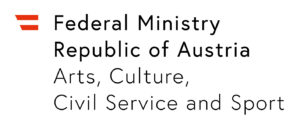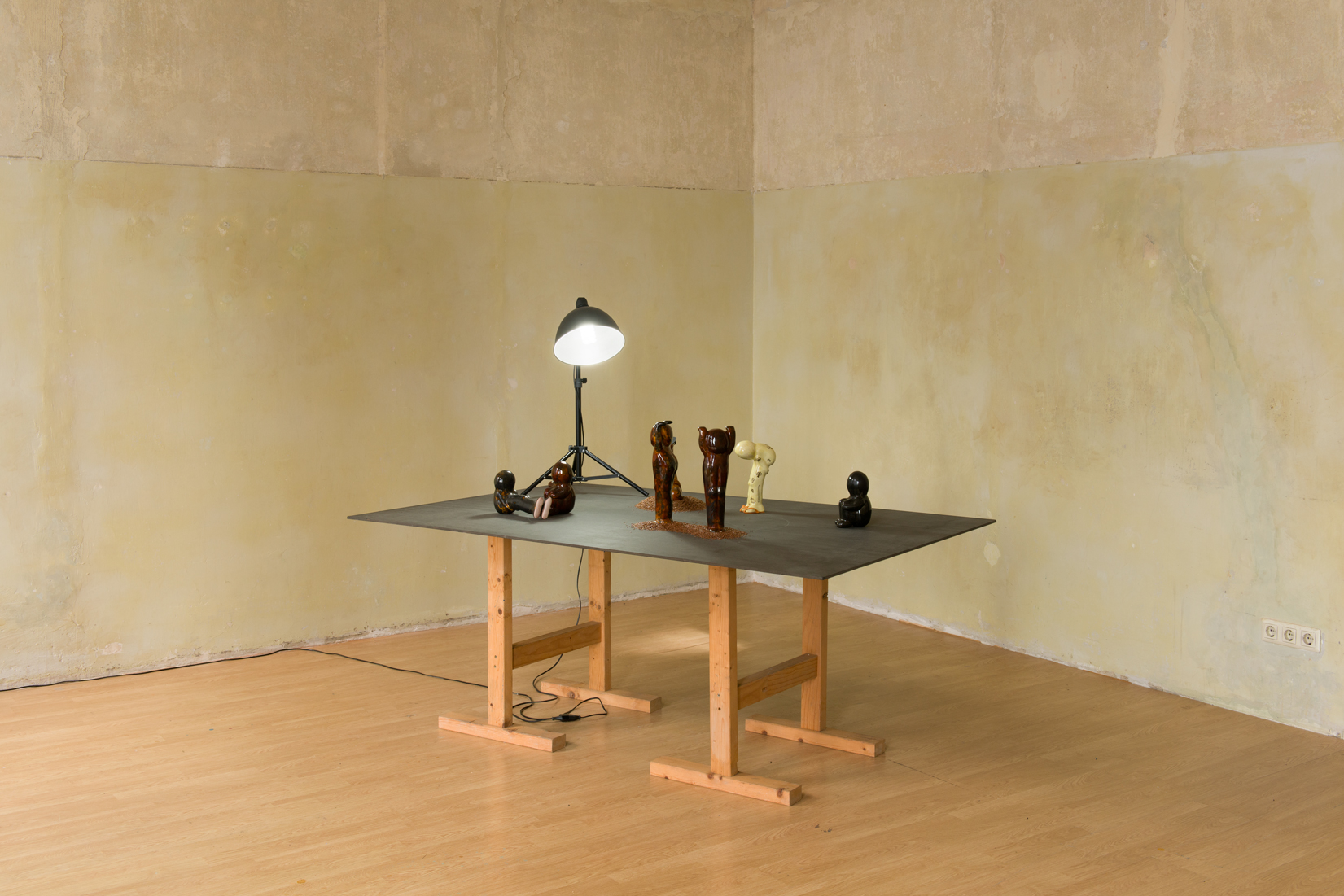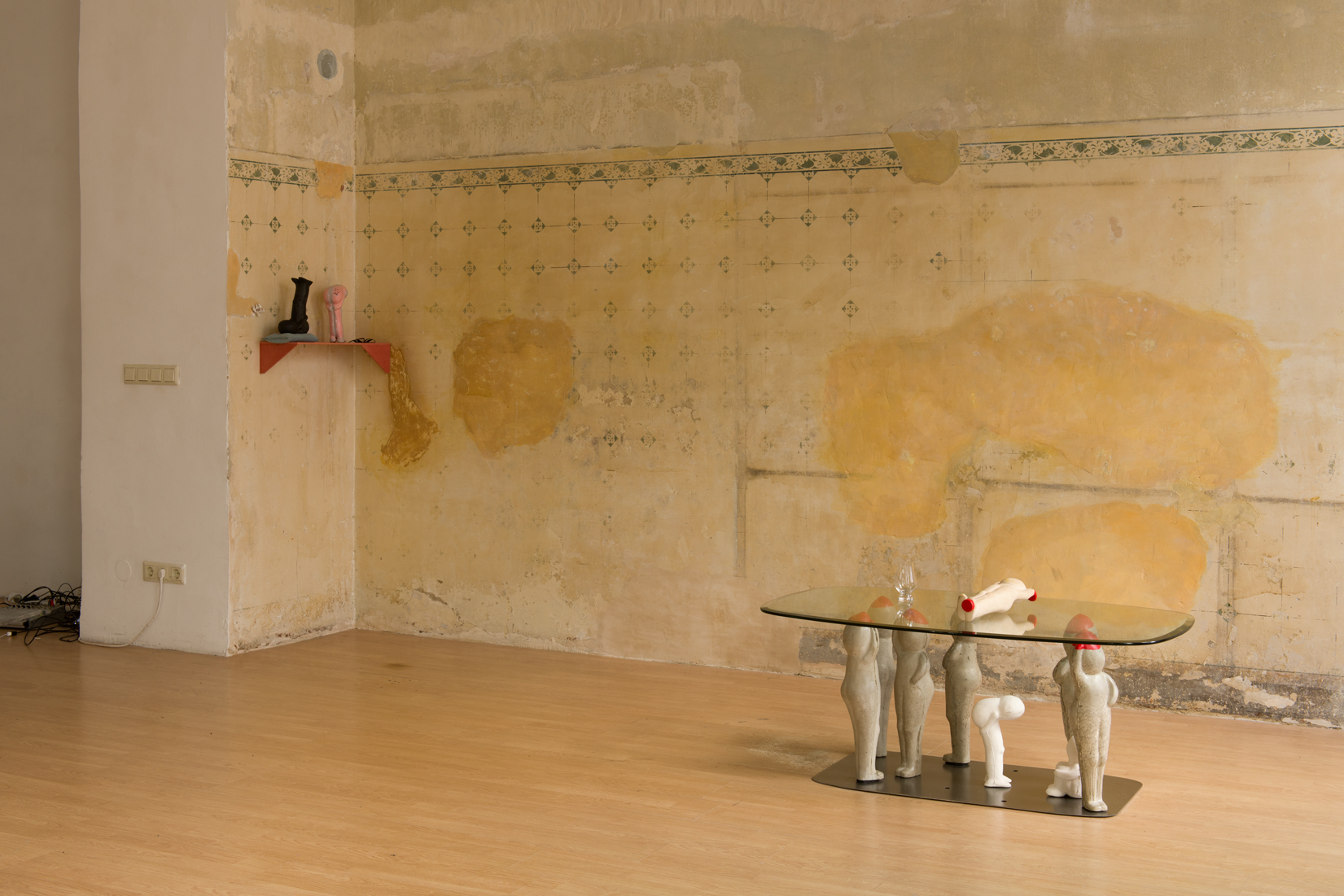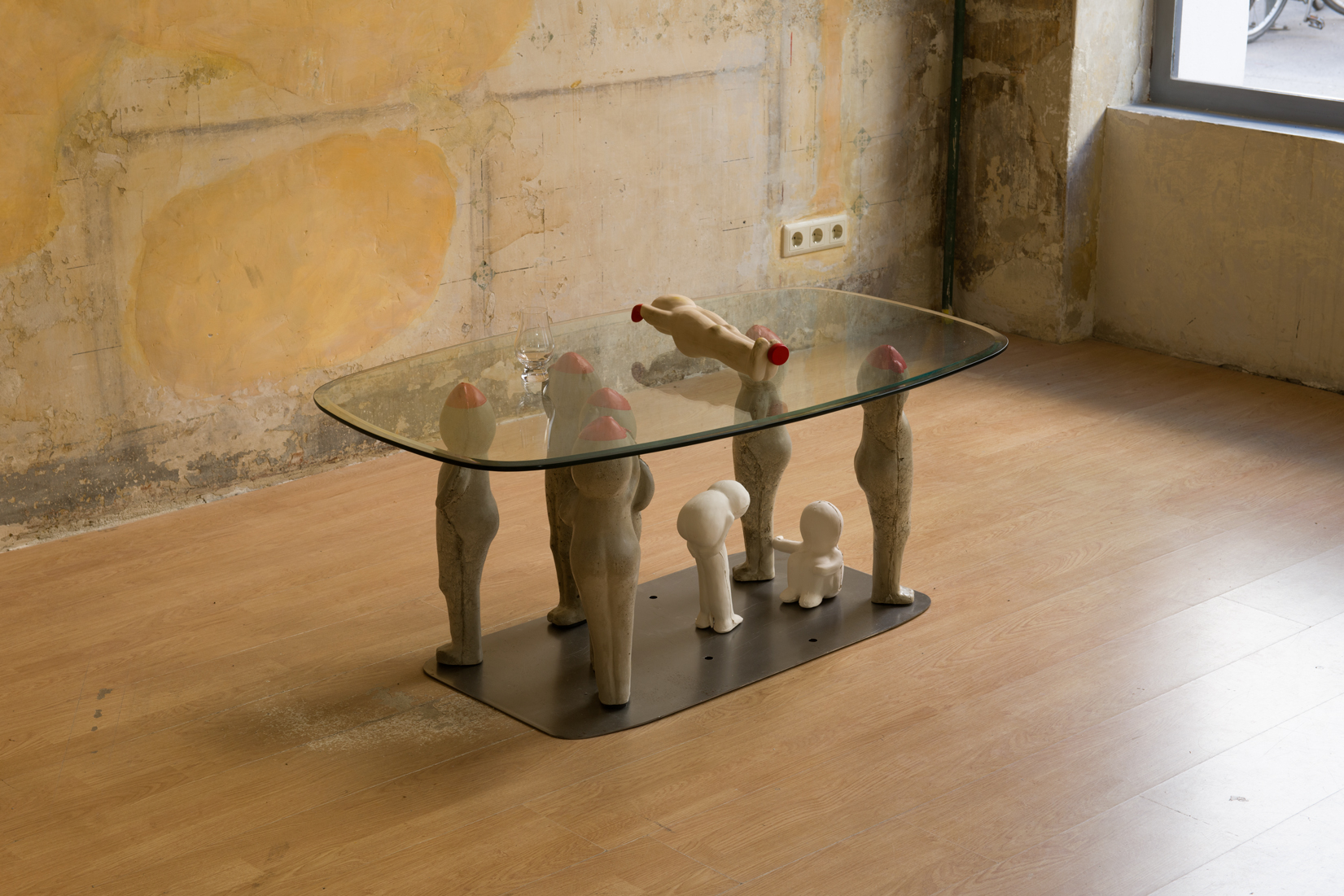Martina Moro
Martina Moro
EGGS R US
Oct 29 – Nov 12 2024
Finissage on Nov 12 from 7 to 9pm!
Unsere Vorstellung vom Modus der theoretischen und praktischen Betrachtung scheint auf den ersten Blick klar. „Da ist ein Mensch“, sagen wir und sehen ihm gegenüber dasjenige, was betrachtet wird. Subjekt und Objekt, Aktives und Passives scheinen eindeutig getrennt voneinander. All das, was hier im Zwischenraum liegt und geschieht, wird als nebensächlich und bedeutungslos beiseite gewischt. So will es die klassische Logik, denn ein drittes, ein Verbindungsglied darf es hier einfach nicht geben. Tertium non datur. Und doch ahnt man, dass die Dinge nicht so einfach gehalten sind, so strikt voneinander getrennt, denn so ergäbe sich in letzter Konsequenz unter anderem auch eine sehr seltsame, paradoxe Vorstellung von Gemeinschaft und Gesellschaft, nämlich als ein Ensemble von Figuren, die ganz mit und bei sich seiend maximal zu einer tangentialen „Berührung“ fähig sind. Nun entspricht dieses Bild nicht dem, was wir als eine wirkliche Gemeinschaft und Gesellschaft erleben? Ebensolches sollte doch mehr sein als bloß eine tangentiale Sache. Auch die Vorstellung, dass wir ganz mit und bei uns zu sein vermögen, ein In-Dividuum abgeben, mutet im Grunde, wirklich ernst genommen, sonderbar an. Wir waren uns doch immer auch schon ein Rätsel, eine relative Verborgenheit, und also etwas, mit und bei dem wir nicht voll und ganz sind. Ähnliche Fragen könnte man auch in Bezug auf das Gegenüber stellen, das wir als Objekt ausweisen: Kann denn dieses wirklich so gestrickt sein, dass es im Gegensatz zu uns, überhaupt kein Mit- und Bei-sich-Sein kennen kann? Ja, woher wollen wir denn all dies wissen? Diese Frage stellt sich insbesondere unter klassisch ontologischen Voraussetzungen, denn die Devise lautet hier ja, dass eine Berührung mit dem anderen immer nur tangential verfasst sein kann. Wie soll unter einer solchen Voraussetzung Einsicht gewonnen werden können? So deutet sich an, dass wir keineswegs so souverän sind, wie wir glauben, gleichwie dass dasjenige, von dem wir vordergründig meinen, wir könnten es grundsätzlich verstehen, öffnen und enträtseln, das Objekt, keineswegs bloß unsouverän uns am Gängelband hängt. Nun also: Wo liegt die Grenze zwischen Subjekt und Objekt? Wo liegt der eindeutige qualitative Bruch? Wo soll das Niemandsland sein, dass niemand durchschreiten können sollte? Mit der klassisch ontologischen Vorstellung von Subjekt und Objekt erliegen wir, wie es aussieht, einem Narzissmus. Wir haben uns selbst einen Status der Erhabenheit zuerkannt, der uns so an und für sich nicht gegeben ist. Wir haben verlernt, über uns selbst hinwegzusehen, von uns als Menschen abzusehen. Wir haben verlernt zu sehen, dass das Gegenüber ebenso den Zwischenraum belebt, wie wir, dass wir uns selbst in gleicherweise ein Rätsel sind, wie es uns das, der, oder die andere zu sein vermögen. Wir haben verlernt anzuerkennen, dass nicht nur wir Fragen stellen und Antworten geben, dass nicht nur wir mit Bedeutungen und Hypothesen agieren, ja dass alles, was ist, ein relatives Subjekt und Objekt ist, innen und außen. Wir haben, von uns und unserem Status geblendet, verlernt in Relationen zu denken, im Hinblick auf eine relative Verbundenheit. Die Verbindungen und Verstrickungen, die uns mit anderem zusammenkommen lassen, sind eben nicht tangential gehalten, sondern gehen mitten hindurch durch all das, was ist – auch durch uns selbst. Das Gesellschaftliche, das Soziale ist keineswegs etwas, das der Mensch allein mit sich bzw. unter sich ausmachen kann. Immerhin sind wir selbst Teil der allumfassenden und relativen kosmischen Gemeinschaft – ein Teil des kosmischen Eies.
Text by Peter Brandlmayr
–––
Our conception of the mode of theoretical and practical observation seems clear at first glance. „Behold the human“, we say, and we see, facing the person, that which is being observed. Subject and object, active and passive, seem distinctly separated from each other. Everything that lies and unfolds in the in-between space is brushed aside as incidental and meaningless. This is what classical logic insists on, for here, there simply must not be a third, a connecting link. Tertium non datur. And yet one suspects that things are not quite so simple, not so strictly separated from one another, for this would ultimately lead, among other things, to a very strange, paradoxical idea of community and society, namely, as an ensemble of figures that, being entirely with and at themselves, are at most capable of tangential ‘touch’. Now, doesn’t this image fail to correspond to what we experience as a true community and society? It should surely be more than merely a tangential affair. Likewise, the notion that we are capable of being entirely with and within ourselves, to be an in-dividual, seems, if taken seriously, rather peculiar. After all, we have always been something of a mystery to ourselves, a relative hiddenness, and thus, something with which and in which we are not fully and entirely complete. Similar questions could also be raised regarding the Other that we declared as an object: Can this object truly be configured in such a way that, in contrast to us, it knows nothing at all of a being-with-itself or being-present-to-itself? And how are we supposed to know all this? This question arises particularly under classical ontological presuppositions, for the dictum here is that contact with the Other can only ever be constituted tangentially. How, under such presupposition, can insight be gained? This indicates that we are by no means as sovereign as we believe, just as what we ostensibly think we can fundamentally understand, uncover, and unravel—the object—does not merely hang from us, tied to leading strings, in an unsovereign manner. Now, then: where is the division between subject and object? Where is the clear qualitative break? Where is the No-man’s land that no one should be to traverse? With the classical ontological notion of subject and object, it seems that we are succumbing to a kind of narcissism. We have granted ourselves a status of sublimity that is ours in and of itself. We have unlearned how to look beyond ourselves, to see past ourselves as humans. We have unlearned how to see that also the Other is animating the in-between space, just as we do, that we are as much a mystery to ourselves as the Other is to us. We have unlearned how to acknowledge that we are not the only ones asking questions and providing answers, not the only ones operating with meanings and hypotheses, that all that exists is a relative subject and object, inside and outside. Blinded by ourselves and our status, we have unlearned how to think in relations, with regard to a relative connectedness. The connections and entanglements that allow us to come together with Others are precisely not tangential but rather run right through everything that exists – including ourselves. The societal, the social, is by no means a matter humans can resolve solely with or among themselves. After all, we ourselves are part of the all-encompassing and relative cosmic community – a part of the cosmic egg.
Text by Peter Brandlmayr
English translation by Juri Velt
Photo credits: Stefan Lux
Opening hours during the exhibition:
Friday from 4 – 8pm
…or by appointment!
Contact:
Marxergasse 16
A-1030 Wien
email: fox(at)udobohnenberger.com
With the kind support of:

![]()

















